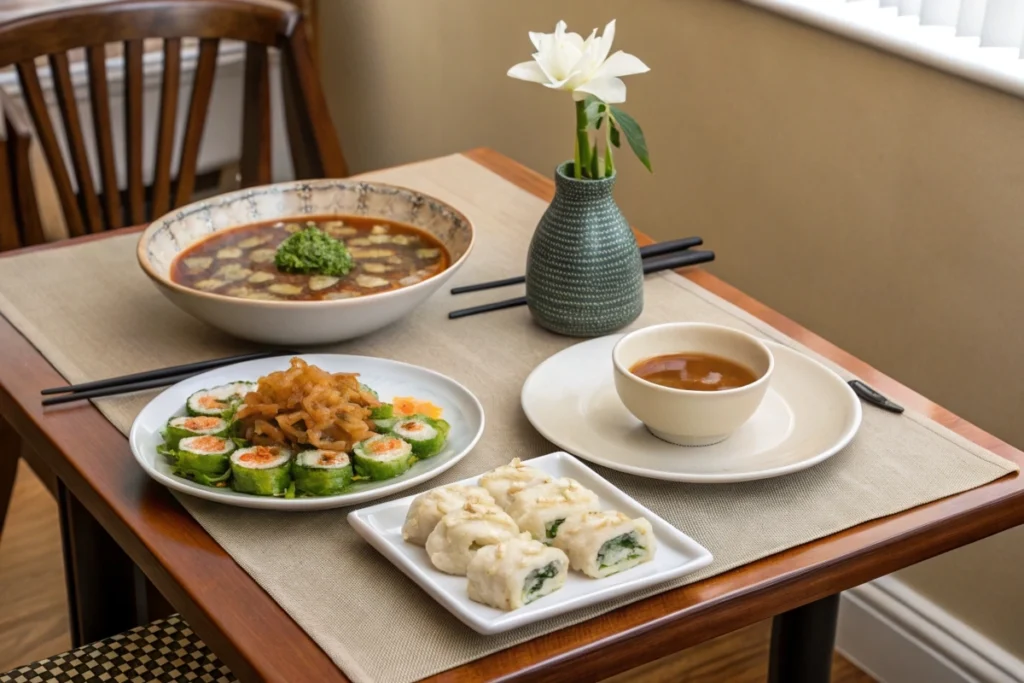Have you ever wondered about the difference between chinese and japanese food and how to distinguish their unique tastes and cultural significances? While both cuisines hail from East Asia, each boasts distinctive histories, flavors, and cooking methods that have captured global attention. Chinese food is often characterized by hearty stir-fries, bold seasonings, and communal dining experiences, whereas Japanese food focuses on minimalism, seasonal ingredients, and refined presentations. Both, however, share a profound respect for fresh produce and balanced flavors.
In this 3,000-word guide, we’ll explore the key contrasts between Chinese and Japanese cuisines, diving into their roots, signature techniques, flavor profiles, and iconic dishes. We’ll also discuss the modern fusion trends that are bridging these culinary traditions in new and surprising ways. Whether you’re trying to decide which takeaway menu to order from or planning to replicate an authentic dish at home, a deeper understanding of each culture’s approach to food can enrich your cooking and dining experiences.
Interested in exploring more about Japanese recipes specifically? Check out easy Japanese recipes to get started on your culinary journey. For now, let’s begin by delving into the philosophical and cultural underpinnings that have shaped Chinese and Japanese gastronomy for centuries.
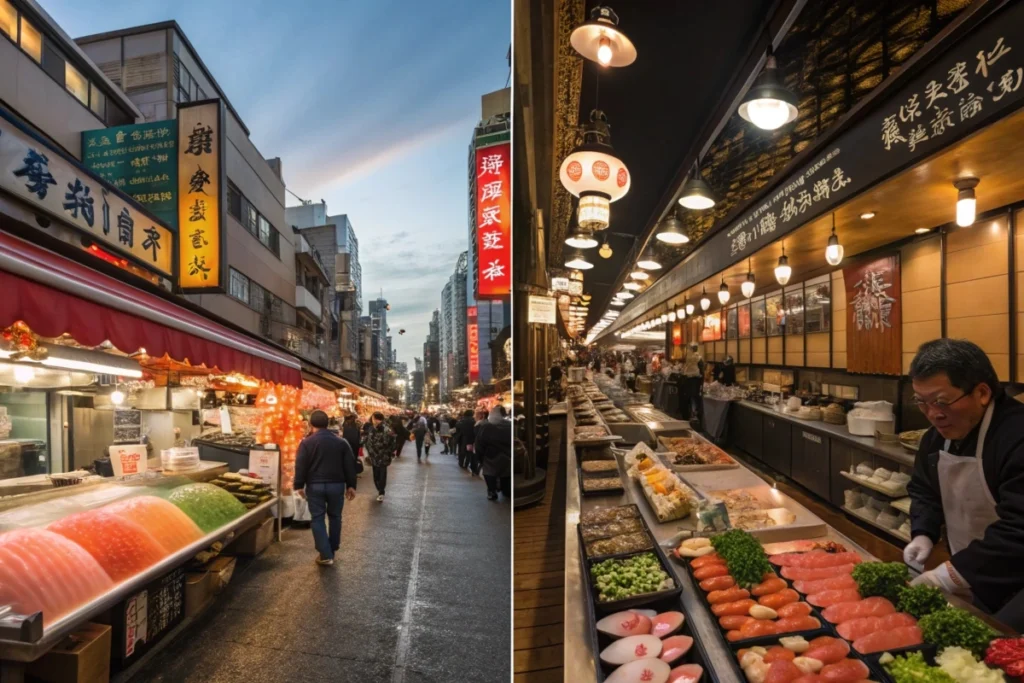
1. Cultural Roots and Culinary Philosophies
Understanding the difference between chinese and japanese food starts with their respective cultural and philosophical foundations. Each cuisine reflects historical values, societal norms, and localized contexts shaped over millennia.
Communal vs. Individual Dining
- China: Dining is highly communal, with family-style meals served on large round tables. Dishes are shared, encouraging sociability and variety in one sitting.
- Japan: Meals often come in individual sets. Even in home-cooked dinners, each person might receive a tray or bento box, featuring separate portions of rice, soup, and side dishes. This approach underscores portion control and mindful presentation.
Philosophical Influences
- Chinese Yin-Yang and Five Elements: Traditional Chinese cooking often harmonizes “hot” and “cold” foods for balance. Ingredients are chosen not just for taste, but also for bodily harmony and wellness.
- Japanese Minimalism: In Japanese cuisine, less is more. The practice of wabi-sabi acknowledges imperfection but celebrates simplicity. Seasonality—known as shun—leads to rotating menus highlighting fresh produce at its peak.
Ritual and Etiquette
- China: Banquets might involve elaborate toasts with baijiu (Chinese liquor), while certain holidays revolve around specific dishes (e.g., dumplings for Lunar New Year). Slurping noodles or lifting bowls to your mouth can be entirely acceptable.
- Japan: Etiquette stresses quiet respect. Slurping noodles is common, but passing food from chopstick to chopstick is taboo. Shinto influences emphasize cleanliness and purity in food presentation.
Regional Diversity
- China: With 34 provincial-level regions, cuisine spans the sweet sauces of Cantonese cooking, the fiery peppers of Sichuan, and the dumpling-heavy northern fare.
- Japan: Although smaller geographically, Japan also has regional distinctions. Kansai region (Osaka, Kyoto) focuses on lighter seasoning; Kanto (Tokyo) may be saltier or bolder. Northern Hokkaido emphasizes seafood and dairy, while southern Kyushu embraces pork-based broths.
Chefs on both sides have adopted foreign techniques over time—like the Chinese incorporation of chili peppers (originally from the Americas) or Japan’s introduction of tempura (adapted from Portuguese frying methods). Nonetheless, each cuisine remains anchored in philosophical and cultural concepts that shape every dish. For an example of how tradition meets innovation, you can see the traditional Japanese desserts recipe that balances sweetness with refined elegance, reflecting Japanese culinary ethos.
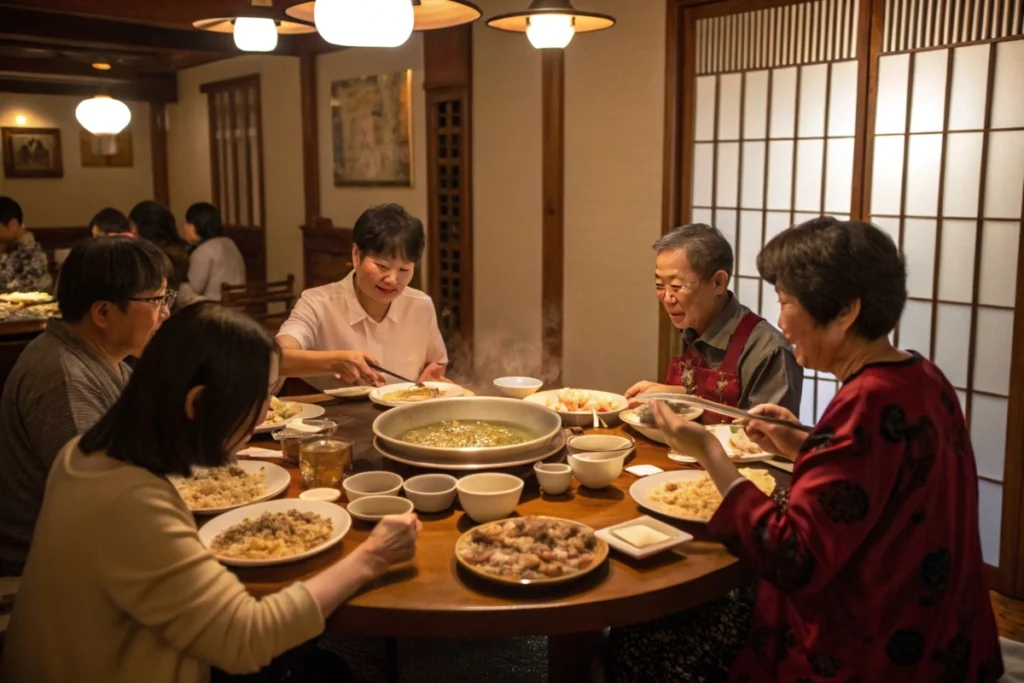
2. Distinct Flavor Profiles and Ingredients
The next major difference between chinese and japanese food revolves around flavor choices and the core ingredients that define each style. While both cuisines value fresh produce, their interpretations of “delicious” diverge.
Chinese Flavor Profile
- Bold Seasonings: Soy sauce, oyster sauce, hoisin, chili paste, and fermented bean curd contribute to layered tastes. Garlic, ginger, scallions, and star anise also appear frequently.
- Dynamic Heat: Regions like Sichuan or Hunan rely heavily on chili peppers, producing dishes that leave a numbing or tingly sensation.
- Sweet & Sour Combinations: Cantonese cooking often marries sweet notes with tangy sauces, such as sweet-and-sour pork.
- Varied Proteins: Pork, chicken, beef, fish, and an array of shellfish can appear in numerous recipes. Tofu (bean curd) also plays a central role, especially in vegetarian or Buddhist temple dishes.
Japanese Flavor Profile
- Umami Emphasis: Dashi (broth made from kelp and bonito flakes), miso, and soy sauce form the backbone of Japanese savory tastes. They create subtlety, letting the natural sweetness of fish or vegetables shine.
- Minimal Seasoning: Light sauces, wasabi, or pickled ginger accompany dishes without overwhelming them. Sushi fish is sometimes only brushed with soy sauce.
- Fresh & Seasonal: Many dishes revolve around the idea that each ingredient’s essence should stand out. This is why sashimi is served raw, preserving purity.
- Rice & Noodles: While China also loves rice and noodles, Japanese versions—like short-grain sushi rice or buckwheat soba—often get their unique identities from the cooking method and minimal accompaniments.
Overlaps and Shared Ingredients
- Both rely on soy-based products (tofu, soy sauce), though the brand and fermentation style can yield different tastes.
- Rice is fundamental, but Japanese short-grain “sticky” rice contrasts Chinese long- or medium-grain varieties, which can be less sticky. Japanese radish recipe and other veggie dishes highlight how produce overlaps but is prepared distinctly in each cuisine.
Balancing Richness with Lightness
Chinese cooking can sometimes appear “oilier” or more intensely flavored, particularly in stir-fries or red-braised dishes. Meanwhile, Japanese fare often focuses on clarity, like a miso soup with limited garnish or a chirashi bowl where each sushi ingredient is showcased. Despite this, modern variations can challenge stereotypes; you may find Japanese curries featuring thicker sauces or lighter Chinese herbal soups that are surprisingly mild.
Whether you’re savoring spicy mapo tofu in a Chinese meal or indulging in delicate sashimi, the flavor experiences differ widely. Chinese dishes often deliver a punchy, robust taste, while Japanese plates tend to remain more restrained, letting each ingredient’s natural character shine. This contrast is part of what draws foodies to explore both cuisines extensively.
3. Cooking Methods and Signature Techniques
Delving into the difference between chinese and japanese food also requires looking at how chefs turn raw ingredients into complex meals. Each tradition employs distinct cooking styles that capture the essence of local produce and highlight unique textures.
Chinese Cooking Techniques
- Stir-Frying
The wok is emblematic of Chinese cuisine. Quick, high-heat cooking ensures vegetables remain crisp and proteins succulent. Dishes like kung pao chicken and chow mein rely on this method. - Braising and Stewing
Think red-braised pork or niurou mian (beef noodle soup). Meats and sauces simmer for extended periods, absorbing robust, layered flavors. - Deep-Frying and Fry-Baking
Egg rolls, spring rolls, sweet-and-sour pork—coatings and batters produce crunchy textures. - Steaming
A healthier alternative employed for dumplings, fish, and vegetables. Bamboo steamers lock in moisture and nutrients.
Japanese Cooking Techniques
- Steaming and Simmering
From chawanmushi (egg custard) to nimono (simmered veggies), these gentle approaches respect natural flavors. - Grilling
Dishes like yakitori or grilled fish typically use minimal marinade, showcasing fresh ingredients. - Raw Preparations
Sashimi, sushi, and tataki highlight pristine cuts of fish or beef. Minimal seasoning—just soy sauce or a dab of wasabi—reinforces the taste of raw produce. - Tempura (Light Frying)
Battered seafood and veggies in a thin, airy crust. Served with tentsuyu (dipping sauce) to keep flavors bright.
Contrasts in Kitchen Equipment
- China: The wok’s wide, curved design fits multiple cooking styles. Bamboo steamers and clay pots also feature strongly.
- Japan: Specialized knives—like yanagiba for slicing fish—ensure precise cuts. Donabe clay pots facilitate slow-cooking or hot pot styles.
Culinary Speed vs. Precision
Because of stir-frying, Chinese kitchens can be quite fast-paced, cooking dishes in minutes. Japanese methods often require delicate knife work or measured plating, giving the cuisine a slower, more deliberate feel. If you’re curious about typical home preparations, you can explore steak-japanese-recipe for a fusion approach bridging these two styles.
Each tradition’s methods reflect broader cultural philosophies: Chinese cooking embraces communal, robust experiences, while Japanese cuisine channels artful restraint. Chefs on both sides might adopt the other’s techniques—like Japanese restaurants offering mapo tofu or Chinese eateries serving sushi—but authenticity is best preserved through consistent usage of tried-and-true methods.
4. Popular Dishes: From Street Eats to Haute Cuisine
A significant part of the difference between chinese and japanese food becomes clear when examining iconic dishes. China’s sprawling territory fosters countless specialties—dim sum, hot pot, Peking duck—while Japan’s top hits include sushi, ramen, and tempura. Below, we outline the most celebrated creations, spanning street-level snacks to high-end meals.
Chinese Highlights
- Dim Sum (Cantonese)
Bite-sized dumplings, buns, and rolls served in bamboo steamers. Often enjoyed at brunch with tea, it’s an opportunity to sample myriad small plates—like shrimp dumplings or custard buns. - Hot Pot (Sichuan, Northern Regions)
A communal pot of simmering broth. Diners dip thin slices of meat, vegetables, and noodles. Flavors range from mild herbal broths to tongue-numbing chili bases. - Peking Duck (Beijing)
Crispy roasted duck served with thin pancakes, scallions, and sweet bean sauce. Symbolic of celebratory feasts. - Mapo Tofu (Sichuan)
A spicy, numbing dish featuring soft tofu and minced pork or beef. Fermented chili bean paste forms the sauce’s base.
Japanese Icons
- Sushi & Sashimi
Celebrated for minimal seasoning, letting the fish or seafood shine. Nigiri (fish atop rice) and maki (rolled sushi) are prevalent. - Ramen
Hearty noodle soup with varied broths (tonkotsu, shoyu, miso). Toppings might include chashu pork, bamboo shoots, or marinated eggs. - Tempura
Lightly battered seafood or vegetables, served with a dashi-based dipping sauce. Crisp exteriors reflect precise frying skills. - Teppanyaki/Hibachi
Known abroad for its theatrical style—chefs flip utensils, create onion volcanoes. In Japan, it’s more subdued, but the concept is similar: cooking on an iron griddle.
Street vs. Fine Dining
China’s street food culture thrives in night markets, offering items like jianbing (savory crepes) or skewered lamb. Japan’s street options revolve around yakitori stands, takoyaki (octopus balls), and okonomiyaki (savory pancakes). Meanwhile, upscale eateries in both countries focus on multi-course experiences—like Chinese banquet-style dinners or Japanese kaiseki. If you have a sweet tooth, check out japanese dessert recipes for matcha-infused pastries or mochi-based confections that highlight Japan’s refined approach.
Whether sampling a spicy bowl of Chinese noodles at a market stall or indulging in a carefully assembled sushi platter in a tranquil Japanese restaurant, these hallmark dishes showcase the best of each cuisine’s heritage. Each is rooted in its culture’s available resources, historical preferences, and overarching philosophies. Next, we’ll delve into modern crossovers and how globalization shapes Chinese-Japanese gastronomic fusions.
5. Modern Crossovers and Future Trends
Globalization and evolving food interests have blurred the lines between chinese food vs japanese food. Today, travelers might find Chinese-inspired ramen shops in Tokyo or sushi burrito stands in Beijing. These culinary crossovers merge local techniques with imported flavors, carving new niches in modern dining.
Fusion Concepts
- Ramen with a Sichuan Twist: Some Tokyo-based ramen chefs incorporate Chinese chili oil or peppercorns, bridging the gap between Japanese noodles and Chinese spiciness.
- Sushi with Chinese Fillings: Rolls may include Peking duck, sweet-and-sour sauce, or even crispy wonton strips to mimic familiar Chinese tastes.
- Dim Sum–Inspired Bento Boxes: Lunch spots abroad might pack dumplings and buns alongside rice and miso soup in a single container, representing the best of both cultures.
Fast-Casual to High-End
In many global cities, you’ll see casual eateries serving “pan-Asian” or “Chinese-Japanese” menus, offering everything from stir-fried udon to sweet-and-sour sushi rolls. Meanwhile, Michelin-starred restaurants are experimenting with refined fusion plates, like delicate sashimi topped with black bean sauce or dumplings stuffed with miso-seasoned ground meat. This diversity underscores how each cuisine evolves to accommodate eclectic palates.
Health, Sustainability & Ingredients
As consumers become more health-conscious, chefs from both traditions explore lower-sodium sauces or plant-based adaptations. Vegan and vegetarian versions of Japanese soup broths and Chinese stir-fries are more common than ever. Chefs increasingly adopt local, organic produce, blending farm-to-table ethics with the established philosophies of fresh and balanced tastes. Attempting your own approach at home? Try authentic-japanese-barbecue-sauce-chicken-recipe-easy-delicious to see how minimal changes to marinade can tweak flavor while maintaining authenticity.
Cultural Exchange on Social Media
Platforms like Instagram or TikTok accelerate cross-pollination. Chinese home cooks share tutorials on making tamago (Japanese sweet omelet), while Japanese YouTubers demonstrate simplified dumpling wrapping. This real-time exchange fosters vibrant online communities that champion learning from both sides.
The Future of Chinese-Japanese Gastronomy
Expect more pop-up concepts merging the best of each tradition, like a “Xiao Long Bao meets Gyoza” festival or “Sichuan Pepper Rolls” next to nigiri. Festivals celebrating Asian foods are likely to see booths offering “honey-wasabi shrimp” or “char siu ramen.” It’s a sign that global diners crave new flavors but still respect the identity of each origin.
While purists might bemoan the rise of fusion, there’s no denying that modern crossovers introduce these cuisines to broader audiences. Ultimately, such synergy complements rather than replaces traditional cooking, letting fans appreciate how the essence of difference between chinese and japanese food can blend harmoniously in the modern era.
History and Context
The story behind difference between chinese and japanese food doesn’t unfold in isolation. Over centuries, trade routes, migrations, and political shifts shaped how these neighboring countries influenced each other’s culinary landscapes—and how they eventually distinguished themselves.
Ancient Ties and Early Exchanges
Trade across the Yellow Sea and East China Sea dates back to antiquity. When Buddhism traveled from China to Japan (around the 6th century), it brought not only religious teachings but also vegetarian influences and the use of tofu and soy. Japanese monks studied in Chinese temples, learning about tea cultivation (leading to the Japanese tea ceremony). Yet, each side used these concepts in unique ways—China refined broad regional palettes, while Japan specialized in minimal, spiritual approaches to dining.
Feudal Eras and Isolation
During Japan’s Edo period (17th–19th centuries), the country adopted a national isolation policy, limiting foreign contact. This seclusion insulated Japanese food from continuous Chinese input, allowing local chefs to refine traditions like sushi, miso, and soba without major external shifts. Meanwhile, China’s imperial dynasties integrated new ingredients from the West—chili peppers, peanuts—broadening Chinese cooking’s scope.
Meiji Modernization
After reopening to the world in the mid-19th century, Japan saw a surge of Western influence. However, Chinese contributions also lingered. Take ramen, for instance: originally a Chinese wheat-noodle dish called lamian, it was adapted to Japanese palates, eventually becoming a national obsession. Meanwhile, Chinese diaspora communities in Japan introduced dim sum, mapo tofu, and other favorites that local diners tweaked with milder seasonings.
Wartime and Post-War Shifts
Complex historical events, including the Sino-Japanese conflicts in the early 20th century, temporarily strained cultural exchanges. Post-World War II, both nations underwent rapid modernization. Western corporations introduced fast food to urban centers in Asia, which ironically spurred renewed interest in preserving native cuisines. Chinese and Japanese chefs cross-trained internationally, fueling new fusions or revivals of classic regional fare.
Global Boom and Culinary Diplomacy
Today, Chinese and Japanese cuisines each enjoy global prestige—plentiful Chinese restaurants serve lo mein and fried rice worldwide, while sushi or ramen spots flourish in malls and high-end establishments alike. Diplomatic initiatives occasionally deploy “cuisine culture exchanges” to highlight their soft power, presenting both sides as unique but historically interconnected. As markets expand and social media fosters gastronomic curiosity, the lines continue to blur, though deep-rooted philosophies remain distinct.
This historical tapestry clarifies why Chinese and Japanese cuisines diverge so strongly in flavor profiles, methods, and plating. Despite mutual influence, each tradition carved out a specialized identity shaped by unique geographies, religions, and social changes. That’s the essence of what makes comparing their dishes both fascinating and instructive.
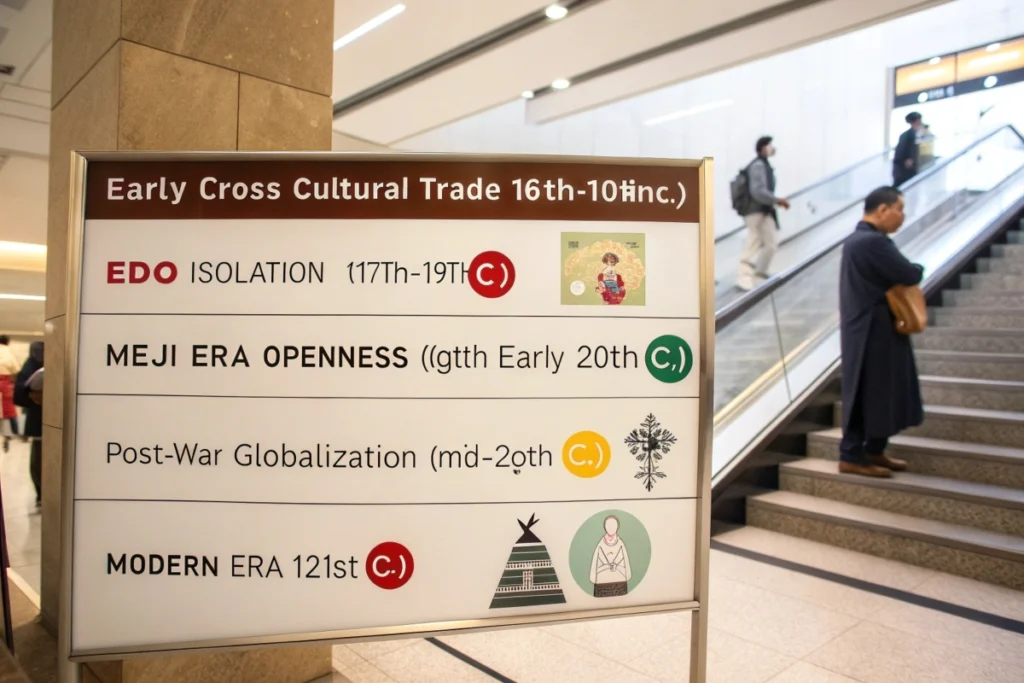
Practical Examples/Use Cases
Scenario 1: A Culinary “Chijapanese” Party
You decide to host a fusion dinner celebrating both cuisines. Guests bring a Chinese or Japanese dish each. One friend arrives with Sichuan-style spicy noodles, another with homemade sushi rolls. You contribute a tempura sweet potato dish featuring North American produce. Throughout the evening, guests compare the bold spiciness of the noodles with the light, crisp flavors of tempura. Conversations spark around the inherent difference between chinese and japanese food—the result is not only a delicious meal but an educational mini-tour of East Asia’s gastronomic wonders.
Scenario 2: Weeknight Home Cooking
On a busy Wednesday, you weigh whether to make a quick Chinese stir-fry or try a simple Japanese miso soup with rice. Instead, you blend the two: a stir-fried tofu dish lightly flavored with soy sauce and a side bowl of miso soup garnished with scallions. The combination of robust, savory tofu and the gentle comfort of miso exemplifies how these cuisines can coexist smoothly on one table. For more direct Japanese recipe inspiration, browse a vegetables-japanese-recipe to see how local produce can adapt.
Scenario 3: Gastronomy Tour Abroad
A travel blogger organizes a 2-week itinerary: one week in China, one in Japan. In China, the blogger explores Xi’an for hand-pulled noodles, Chengdu for hot pot, and Guangzhou for dim sum. In Japan, they savor ramen in Tokyo, sashimi in Osaka, and onsen tamago (hot spring eggs) in the rural countryside. As the blogger documents the trip, they highlight how regionally diverse each country can be, further emphasizing that one cannot reduce Chinese or Japanese food to a single monolithic style.
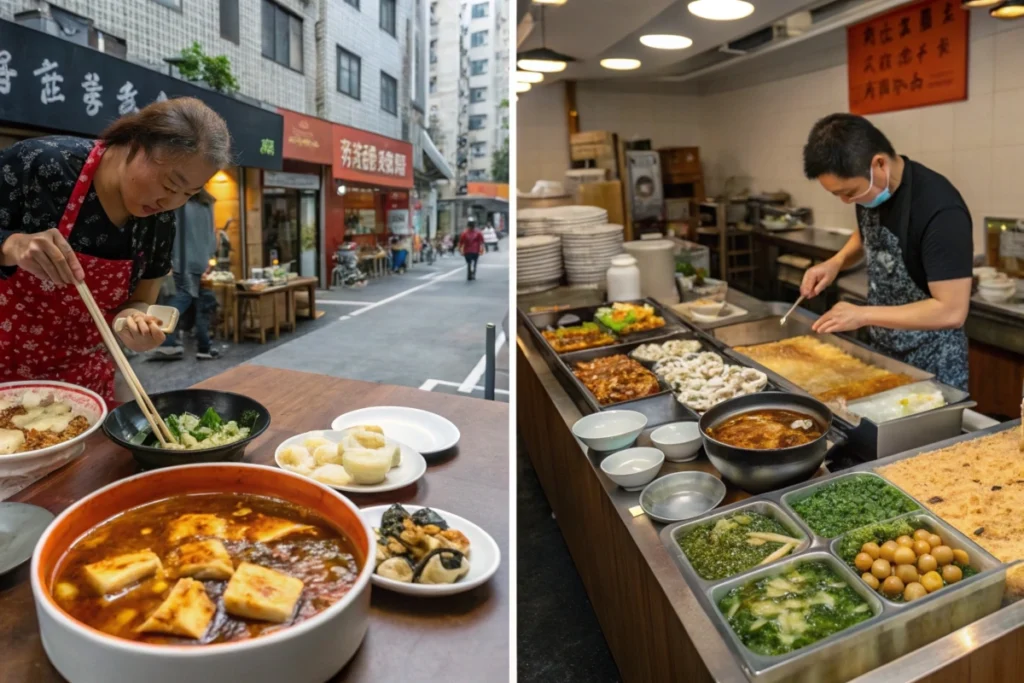
FAQs
Curious about specific aspects of difference between chinese and japanese food? Below are common inquiries:
- What is the main difference between Japanese and Chinese food?
Chinese cuisine often emphasizes bold, savory, and sometimes spicy flavors, using stir-frying and deep-frying. Japanese cooking highlights subtlety, fresh ingredients, and minimal seasoning, often served in individual portions. - Do Chinese and Japanese have different cuisine styles?
Yes. While both use rice, soy sauce, and tofu, their methods diverge. China’s methods can be robust (like braising or intense wok frying), whereas Japan focuses on raw fish, light frying (tempura), or delicate simmering. - What about the difference between Japanese rice and Chinese rice?
Japanese rice is short-grain, sticky, and often used for sushi. Chinese rice can vary—long or medium grain, fluffier, and less sticky—suitable for stir-fries like yangzhou fried rice. - Are there commonalities in seasonings or sauces?
Both rely on soy sauce, but Chinese versions may be darker and thicker, while Japanese soy sauce can be lighter in color but deeper in umami. Miso is uniquely Japanese, whereas chili bean paste or hoisin sauce lean more Chinese. - Which cuisine is healthier?
Both can be healthy when using fresh ingredients and moderate oil or sodium. Japanese meals are often seen as lighter due to minimal frying and portion sizes. Chinese dishes, especially southern or steamed varieties, can be equally nutritious. - Can I easily replicate these cuisines at home?
Yes. For Chinese stir-fries, you mainly need a wok and sauces like soy sauce, oyster sauce. Japanese dishes often require specific ingredients (wasabi, dashi, mirin) but are also accessible. Try a japanese-chicken-fried-rice-recipe or classic Chinese fried rice to start. - How do their dessert styles differ?
Chinese desserts often involve sweet beans or glutinous rice. Japanese sweets rely heavily on matcha, mochi, or anko (red bean paste). Both are typically less sweet than Western desserts.
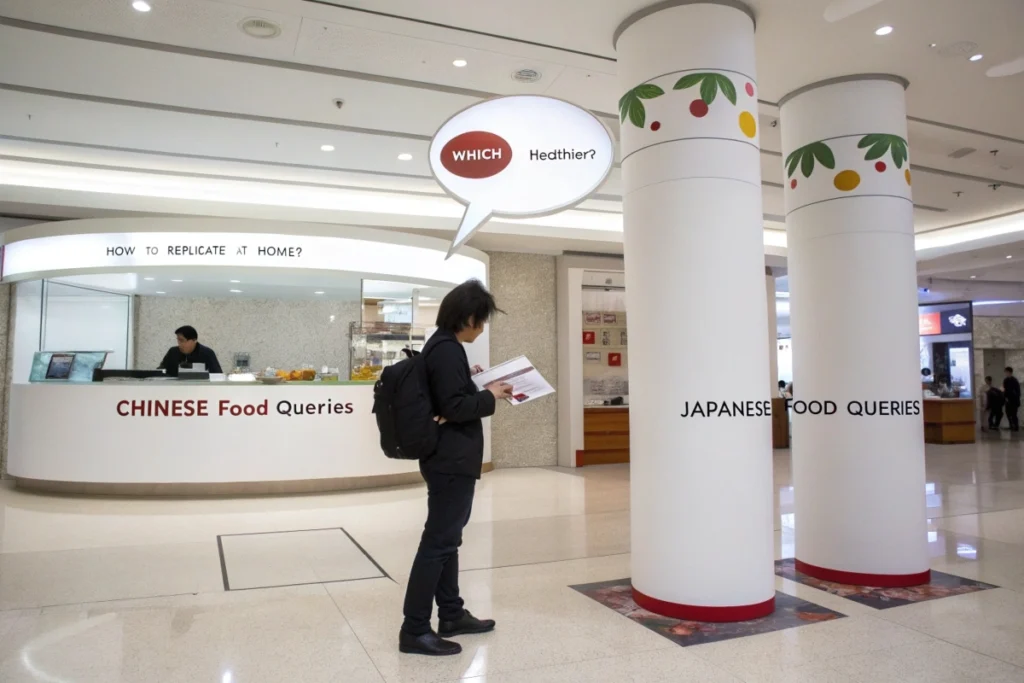
Conclusion
When exploring the difference between chinese and japanese food, it’s clear each cuisine embodies distinct cultural values and culinary priorities. Chinese cooking is strongly communal, often robustly seasoned, and thrives on dynamic techniques like stir-frying. Japanese cuisine tends to be more restrained, focusing on subtlety and presentation, with dishes like sushi or tempura that underscore the natural flavors of fish and vegetables.
Yet these traditions are not static. Modern fusion restaurants blur lines, combining Chinese spice with Japanese aesthetics or turning a sushi roll into a dim sum-inspired treat. Understanding their core differences can guide you in choosing which style aligns best with your taste or dietary goals. If you’re craving bold heat and communal feasting, Chinese dishes may be your go-to. For a minimalist, refined experience that highlights fresh produce and measured seasoning, Japanese fare delivers an elegant alternative.
Should you feel inspired to try authentic Japanese recipes in your own kitchen, these easy Japanese recipes can be your starting point. Meanwhile, countless Chinese classics beckon for exploration if you’re after hearty soups or sizzling stir-fries. Ultimately, both cuisines enrich the global culinary scene in complementary ways, offering endless possibilities to delight your palate.
